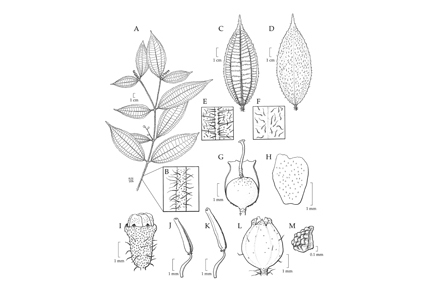Abstract
Miconia sparsiflora is described as a new species known only from lower montane tropical forests on the Caribbean slopes of Panama. A line drawing, a distribution map, a recommended conservation assessment, and comparisons with presumed closest relatives based on morphology are provided. This species is readily recognized by its copious mixture of smooth spreading black trichomes and ground layer of brown amorphous branlike indumentum on cauline internodes, leaves with ciliate-denticulate margins, rounded bases, and an abaxial indumentum consisting of spreading smooth trichomes 0.5–2 mm long on and between elevated veins and also randomly covered with minute amorphous branlike trichomes and glistening resinous-granulose trichomes on and between the elevated primary, secondary, and higher order veins. Other distinctive features include its few-flowered racemiform inflorescence with flowers that are nodding in bud, stamens that are alternately somewhat unequal in length, and seeds with a bluntly tuberculate testa. The new species is compared with the widespread M. gracilis and two species of northwestern South America, M. subspicata, and M. tenensis.
References
- Almeda, F. (2009) Melastomataceae. In: Davidse, G., Sousa, M., Knapp, S. & Chiang, F. (Eds.) Flora Mesoamericana Vol. 4 Cucurbitaceae a Polemoniaceae. Universidad Nacional Autónoma de México, México D.F., pp. 164–337.
- Almeda, F. (2013) A new epiphytic species of Blakea (Melastomataceae: Blakeeae) from the Caribbean rainforest of Costa Rica. Selbyana 31: 1–4.
- Almeda, F. & Penneys, D.S. (2013) New and reconsidered species of Tropical American Melastomataceae. Brittonia 66: 160–169. https://doi.org/10.1007/s12228-013-9320-2
- Almeda, F. & Penneys, D.S. (2018) Blakea echinata (Melastomataceae: Blakeeae): a new species from the Caribbean rainforest of Panama. Phytotaxa 372: 104–110. https://doi.org/10.11646/phytotaxa.372.1.9
- Almeda, F. & Ortíz, O.O. (2022) Miconia amplipedunculata (Melastomataceae: Miconieae), a new species from the Caribbean lowlands of Panama. Phytotaxa 575: 294–300. https://doi.org/10.11646/phytotaxa.575.3.7
- Bachman, S., Moat, J., Hill, A.W., de la Torre, J. & Scott, B. (2011) Supporting red list threat assessments with GeoCAT: Geospatial conservation assessment tool. ZooKeys 150: 117–126. https://doi.org/10.3897/zookeys.150.2109
- Beentje, H. (2016) The Kew Plant Glossary: an illustrated dictionary of plant terms. 2nd ed. Kew Publishing, Royal Botanic Gardens, Kew, 184 pp.
- Gamba, D. & Almeda, F. (2014) Systematics of the Octopleura clade of Miconia (Melastomataceae: Miconieae) in Tropical America. Phytotaxa 179: 1–174. https://doi.org/10.11646/phytotaxa.179.1.1
- Harris, J.G. & Harris, M.W. (2004) Plant identification terminology: an illustrated Glossary. 2nd ed. Spring Lake Publishing, Spring Lake, Utah, 206 pp.
- IUCN Standards and Petitions Committee. (2024) Guidelines for Using the IUCN Red List Categories and Criteria. Version 16. Prepared by the Standards and Petitions Committee. Available from: https://www.iucnredlist.org/documents/RedListGuidelines.pdf (accessed 12 January 2025)
- Kriebel, R. & Santamaria, D. (2013) A new species of Blakea (Melastomataceae) from Panama with foliaceous sepal appendages and zygomorphic flowers. Brittonia 65: 1–4. https://doi.org/10.1007/s12228-012-9250-4
- Markgraf, F. (1934) Neue andine Melastomataceen. Notizblatt des Botanischen Gartens und Museums zu Berlin-Dahlem 12: 177–182.
- Michelangeli, F.A., Goldenberg, R., Almeda, F., Judd, W.S., Bécquer, E.R., Ocampo, G., Ionta, G.M., Skean Jr., J.D., Majure, L.C. & Penneys, D.S. (2019) Nomenclatural novelties in Miconia (Melastomataceae: Miconieae). Brittonia 71: 81–121. https://doi.org/10.1007/s12228-018-9546-0
- Michelangeli, F.A. & Santamaria, D. (2020) A new species of Blakea (Melastomataceae: Blakeeae) with pendulous flowers from Costa Rica. Phytotaxa 442: 12–17. https://doi.org/10.11646/phytotaxa.442.1.2
- Michelangeli, F.A., Nicolas, A.N., Ocampo, G., Goldenberg, R., Almeda, F., Judd, W.S., Bécquer, E.R., Skean Jr., J.D., Sosa, K., Caddah, M.K., Ionta, G.M., Penneys, D.S., Alvear, M., Burke, J.M. & Majure, L.C. (2022) Why recognize Miconia as the only genus in tribe Miconieae (Melastomataceae)? In: Goldenberg, R., Michelangeli, F.A. & Almeda, F. (eds.) Systematics, Evolution, and Ecology of Melastomataceae. Springer, Cham, Switzerland, pp. 235–254. https://doi.org/10.1007/978-3-030-99742-7_10
- Mittermeir, R.A., Gil, P.R., Hoffman, M., Pilgrim, J., Brooks, J., Mittermeir, C.G., Lamoreux, J. & Fonseca, G.A.B. (2005) Hotspots revisited. CEMEX, Agrupación Sierra Madre, S.C., Mexico City, 392 pp.
- QGIS Development Team (2022) QGIS Geographic Information System. Open Source Geospatial Foundation Project. Available from: http://qgis.org (accessed 4 October 2024)
- Ruiz, H. & Pavón, J. (1794) Florae peruvianae, et chilensis prodromus. Imprenta de Sancha, Madrid, 153 pp. https://doi.org/10.5962/bhl.title.11759
- Samra, K., Lucas, E.J. & Michelangeli, F.A. (2024) Triolena anisophylla (Melastomataceae), a new and threatened species endemic to Panama. Kew Bulletin 79: 1–8. https://doi.org/10.1007/512225-024-10194-4
- Thiers, B. (2025) [continuously updated] Index Herbariorum: A global directory of public herbaria and associated staff. New York Botanical Garden’s Virtual Herbarium. Available from: http://sweetgum.nybg.org/science/ih/ (accessed 4 September 2024)
- Triana, J. (1871 [“1872”]) Les Mélastomacées. Transactions of the Linnean Society of London 28: 1–188. https://doi.org/10.1111/j.1096-3642.1871.tb00222.x
- Ulloa Ulloa, C., Almeda, F., Goldenberg, R., Kadereit, G., Michelangeli, F.A., Penneys, D.S., Stone, R.D. & Veranso-Libalah, M.C. (2022) Melastomataceae: Global diversity, distribution, and endemism. In: Goldenberg, R., Michelangeli, F.A. & Almeda, F. (eds.) Systematics, Evolution, and Ecology of Melastomataceae. Springer, Cham, Switzerland, pp. 3–28. https://doi.org/10.1007/978-3-030-99742-7_1
- Wurdack, J.J. (1978) Certamen Melastomataceis XXIX. Phytologia 41: 1–10.
- Wurdack, J.J. (1980) Melastomataceae. In: Harling, G. & Sparre, B. (eds.) Flora of Ecuador, vol. 13. pp. 1–406.


